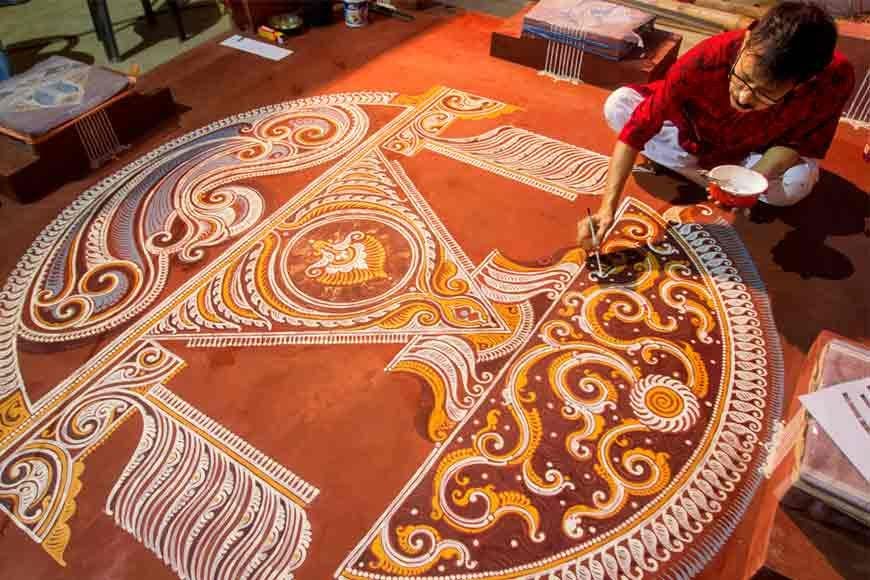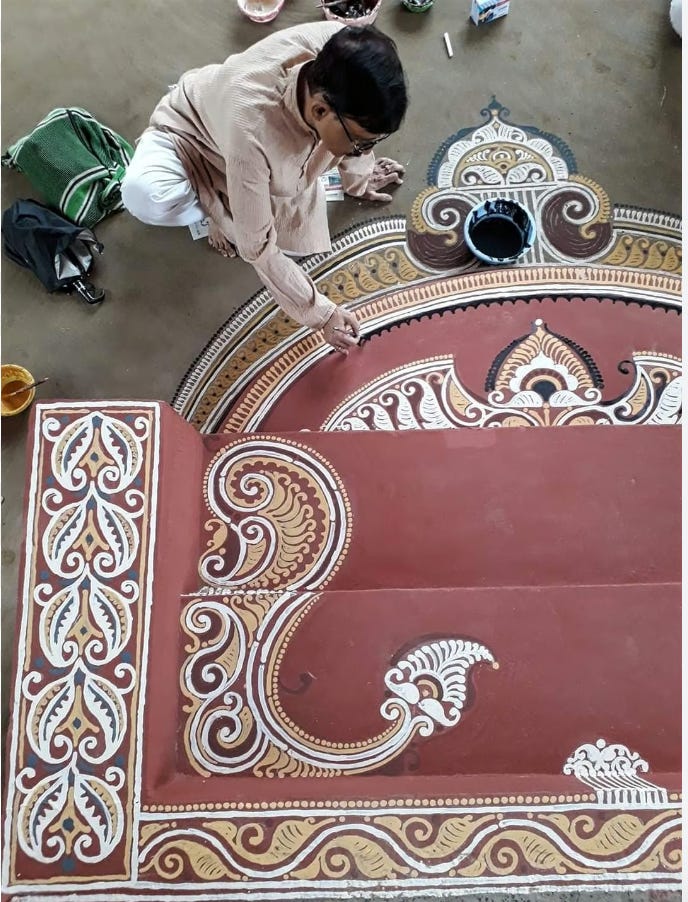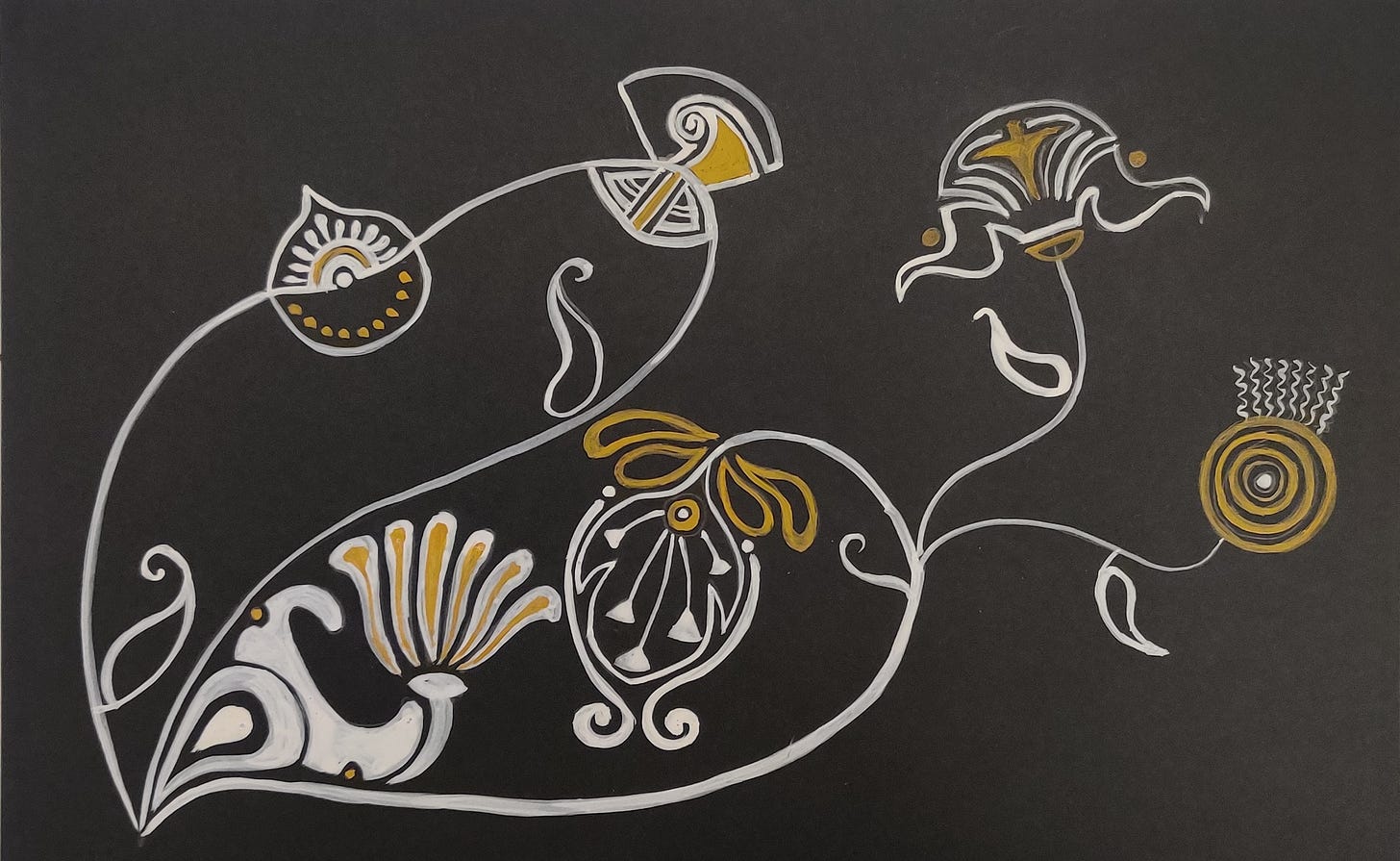Alponas and all things Aesthetic
How an artform from over a-thousand-years ago still exists today! ...
Hi,
First of all. I owe you an apology. Not only am I late this month, but I completely missed the mark with the topic as well. I promised everyone a spicy saga on flow and it’s connection to creativity, but alas I got distracted. But hear me out..It’s a good distraction. And don’t worry we’ll still be revisiting flow in next month’s newsletter so no promises have gone to waste.
I recently went on a two day immersive workshop on Alpona making and became fascinated (more than the average person) with the beauty of this artform…
What is this ‘Alpona’, I hear you say?
Well it’s this…
It’s also this..
and this…
but not this…
As you can see the common thing shared by all the alponas above (excluding mine that is) is that they all exist on the ground. Decorating the floor is not uncommon in India, and has emerged as a ritualistic practise since pre-colonial times to commemorate various events from auspicious festivals to weddings. Spiritual meanings were embodied in these patterns, which were often constructed around a specific theme, depending on the occasion.
Practically every state in India practises some form of floor painting. you have the Aripan in from Bihar, the Kolam in Tamil Nadu, Mungli in Andhra Pradesh, Likhnu in Himachal and Haryana… the list goes on!
Say hello to Bengal’s 𝘈𝘭𝘱𝘰𝘯𝘢
I virtually grew up with the bengali style of floor painting called ‘Alpona’. In a community oriented culture, it was almost force of nature to come together with family to adorn the entrance of our house with alpona during pujas (days of worship).
Whilst I mostly observed these growing up, either watching relatives of the house making these or at spiritual places like temples, I never really appreciated or questioned the existence of this artform. I mean why would I? I was a kid and all I wanted to do was eat and play and be as far away from boring adults for as long as possible.
Yet…. it still baffles me how these patterns have remained tucked in my what-I-thought-was-a-selective memory to this day. And decades later, coming across the advert for this workshop I took part in felt like a heart-warming coincidence, an almost signal from the universe to go on and explore these patterns, and perhaps rekindle my creative self through these vibrant emblems of my cultural heritage.
A little back story…
Alpona, named after the Sanskrit word ‘alimpana’, meaning ‘to plaster’ originated from these daily rituals performed by agrarian folk of the pre-vedic times (circa 1750 BCE).
It was believed that these rituals or ‘Broto’ when manifested pictorially on the ground would help in the fulfilment of particular desires. Most often they were done with respect to specific deities, in return for blessings.
Alponas would be applied with the hand, and made using a paste of refined rice. They were traditionally performed by women, to whom this art offered a creative escape from the mundane routines of household chores.
Evolution in Santiniketan: Renovating Tradition
In the 1900s, the polymath Rabindranath Tagore recognised how imperial colonialism threatened to severe people from their roots, values and culture.
And so shortly after establishing his Santiniketan school Visva-Bharati, Tagore took it upon himself to bring about a cultural regeneration through education in the arts and crafts of India. He introduced Alpona as a creative catalyst of this nationalist movement, encouraging the students at his school to become aware of, and collectively engage in the making of Alponas.
The renowned artist and teacher Nandalal Bose was appointed by Tagore to lead this artistic transformation in Santiniketan. He took inspiration from the immediate flora and fauna around him (i.e the trees, birds and fishes) as well as from the ancient paintings in the Ajanta and Bagh Caves of Maharashtra. All these gave rise to the non-secular motifs present in the contemporary Alpona style that we see today.
Similarities with other cultures…
There lies a strong resemblance between the Alpona and those artforms found in many communities outside India. For instance, the Aztec communities from North Mexico made art with symbols which were rooted in their beliefs around gods and goddesses, and referred to elements from natural landscapes of mountains, agricultural fields, and seasons.
Much like the Alpona, metaphors were abundant in Aztec art. The hummingbird represented the sun god, the eagle represented the warrior, and double headed serpent representing fertility (very similar to alpona where the snake had close symbolic connections to fertility)

Some concluding thoughts..
If Tagore had been alive to see how much has changed in today’s world, and how scarce Alponas have become, he perhaps would’ve been disappointed but not surprised. With the rise in individualism and the self-centered lifestyle, many have disregarded the need to achieve a community identity and perhaps deem it without any use to today’s society. But I beg to differ. And so do the surge of research studies that have cropped up in the recent decade or so justifying the impact of the arts on our social health. Whilst there haven’t been any studies relating to the Alpona, it may be worth the effort to see if dabbling in such art can elicit any feelings of emotional growth or social harmony that comes with making something aesthetic.
After all creativity is a primal need. Whether individually, or through group activities, we need to bring the practice of the aesthetic into our day to day life.
A short and sweet video to sum it all up …
After the workshop I had the pleasure of interviewing Sudhiranjan Mukherjee who is an imminent practitioner of Alpona and has significantly contributed to the revival of this artform both in Bengal and internationally. His designs tend to be asymmetrical and he’s not afraid to experiment with colours beyond the conventional red, white and yellow.
I recommend to watch till the end..go on, trade some 5 mins of mindless scrolling on social media to learn something new!
And that’s it! Thanks for reading. This newsletter has been delivered hand-rolled, AI-free, completely supported by my caffeine intake (which in turn is supported by my savings at the moment). So if you like what you read so far, please DO say hello or comment or like or even share (if you’re feeling generous!). It does really make a difference to how I write these in the future..
And of course any suggestions for a deep dive edition on a particular artform is very welcome so don’t hold back. Honestly.
Until next time friends, have a great rest of the week!
Koyel x












